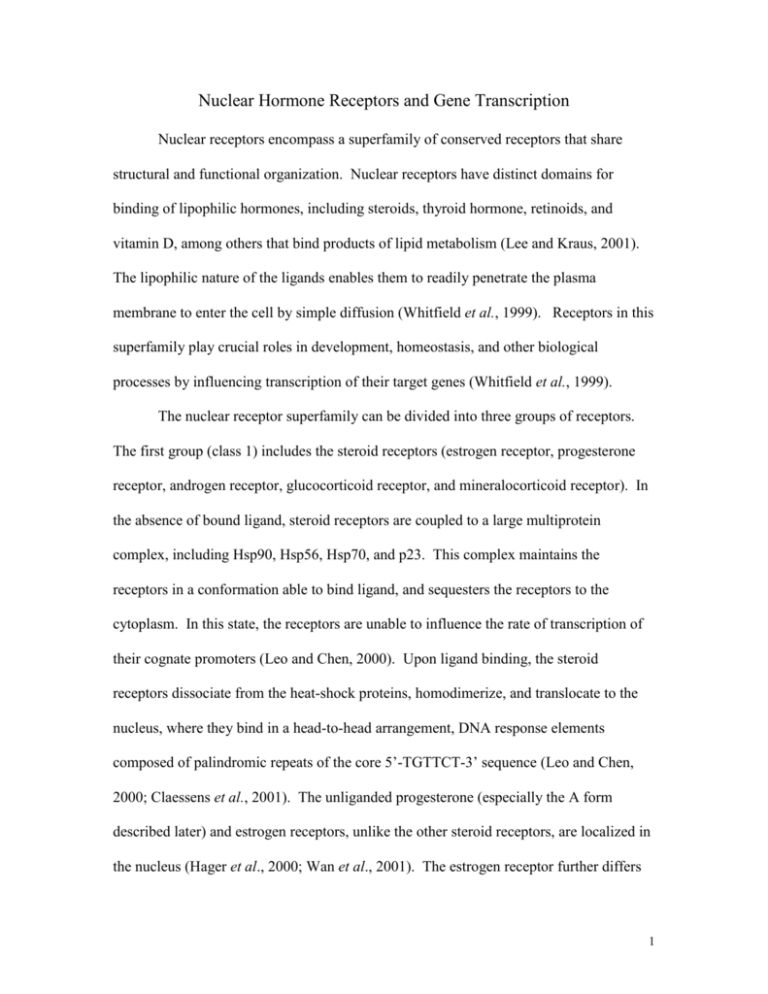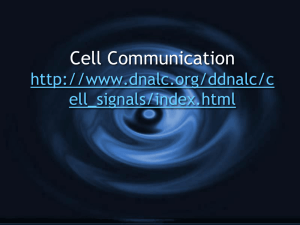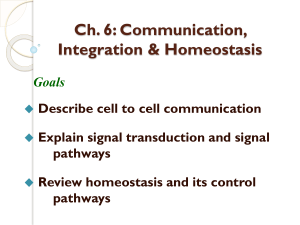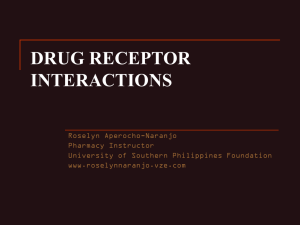Nuclear Hormone Receptors and Gene Transcription
advertisement

Nuclear Hormone Receptors and Gene Transcription Nuclear receptors encompass a superfamily of conserved receptors that share structural and functional organization. Nuclear receptors have distinct domains for binding of lipophilic hormones, including steroids, thyroid hormone, retinoids, and vitamin D, among others that bind products of lipid metabolism (Lee and Kraus, 2001). The lipophilic nature of the ligands enables them to readily penetrate the plasma membrane to enter the cell by simple diffusion (Whitfield et al., 1999). Receptors in this superfamily play crucial roles in development, homeostasis, and other biological processes by influencing transcription of their target genes (Whitfield et al., 1999). The nuclear receptor superfamily can be divided into three groups of receptors. The first group (class 1) includes the steroid receptors (estrogen receptor, progesterone receptor, androgen receptor, glucocorticoid receptor, and mineralocorticoid receptor). In the absence of bound ligand, steroid receptors are coupled to a large multiprotein complex, including Hsp90, Hsp56, Hsp70, and p23. This complex maintains the receptors in a conformation able to bind ligand, and sequesters the receptors to the cytoplasm. In this state, the receptors are unable to influence the rate of transcription of their cognate promoters (Leo and Chen, 2000). Upon ligand binding, the steroid receptors dissociate from the heat-shock proteins, homodimerize, and translocate to the nucleus, where they bind in a head-to-head arrangement, DNA response elements composed of palindromic repeats of the core 5’-TGTTCT-3’ sequence (Leo and Chen, 2000; Claessens et al., 2001). The unliganded progesterone (especially the A form described later) and estrogen receptors, unlike the other steroid receptors, are localized in the nucleus (Hager et al., 2000; Wan et al., 2001). The estrogen receptor further differs 1 from the other steroid receptors in that it recognizes a palindromic repeat of the consensus sequence TGACCT (Claessens et al., 2001; Leo and Chen, 2001). The mechanisms necessary for the steroid specificity of gene regulation are not completely understood, but receptor distribution and hormone metabolism can partially explain in vivo steroid specificity (Claessens et al., 2001). Steroid hormones are important endocrine messengers. Androgen, estrogen, and progesterone are important for control of reproduction and sexual development (Whitfield et al., 1999). In the embryo, the androgen male sex hormones cause the differentiation of the reproductive organs into the male phenotype. Also, increase in androgen production during puberty induces the secondary sexual characteristics (Claessens et al., 2001). The two predominant naturally occurring ligands of the androgen receptor (AR) are testosterone and dihydrotestosterone (DHT). Estrogen female sex hormones produce profound effects on the growth, differentiation, and functioning of many reproductive tissues. However, estrogens also exert actions on other tissues including bone, liver, brain, and the cardiovascular system (Katzenellenbogen et al., 2000). The majority of the actions of estrogens seem to be exerted by two estrogen receptor (ER) subtypes, ER and ER . The levels and proportion of these two receptors are variable in different target cells (Katzenellenbogen et al., 2000). The progesterone receptor (PR) is found in mammalian cells as two variants, PR-A and PR-B. The A form utilizes an alternative initiation signal and is missing the first 164 amino acids of the full length B form (Hager et al., 2000; Rowan and O’Malley, 2000). Progesterone functions to prepare the uterus endometrium for embryo implantation and to maintain pregnancy in the uterus and ovary. It also suppresses milk protein synthesis in 2 the mammary gland during pregnancy and regulates the outgrowth of alveolar structures in the mammary gland (Rowan and O’Malley, 2000; Wan et al., 2001). Glucocorticoids and mineralocorticoids are steroid hormones secreted by the adrenal gland. The mineralocorticoid receptor and its ligand aldosterone control sodium reabsorption and blood pressure (Whitfield et al., 1999). The actions of the glucocorticoids (cortisol) include regulation of glucose metabolism (gluconeogenesis), inhibition of bone formation, and anti-inflammatory and immunosuppressive actions Whitfield et al., 1999; Wan et al., 2001). The second group of nuclear receptors (class II) includes retinoic acid receptors, thyroid hormone receptors, and the vitamin D3 receptor. These receptors are found strictly in the nucleus and form heterodimers with the receptor for 9-cis retinoic acid (RXR). Heterodimer formation with RXR is a necessity because these receptors bind more efficiently to their target sites in the presence of RXR. The heterodimers bind constitutively in a head to tail configuration to DNA response elements consisting of direct repeats of the sequence TGACCT, and in the absence of ligand often exert a repressive effect upon the activity of their promoters (Leo and Chen, 2000). The basic molecular mechanism of the retinoic acid receptor proteins is shown below. Left: The Ligand Binding Domain (LBD) of the receptor is free of hormone and binds a repressor. The DNA Binding Domain (DBD) of the receptor contacts the DNA upstream of the transcription start site. Middle: The binding of the hormone induces a conformational change which results in the expulsion of the repressor. Right: A coactivator binds to the receptor and switches on transcription. 3 A series of receptors bind DNA only when heterodimerized to RXR. In that case, each member of the dimer takes part in the regulation of the metabolic pathways activated. Interestingly, the heterodimer can activate the transcription of different genes, whether no ligand, an agonist, or an antagonist is bound to one receptor or the other. The figure below is a model for the synergetic activation of the RAR-RXR heterodimer. A: Both receptors are unliganded. A repressor (bricks) binds to RAR (white) and prevents transcription. B: RAR is activated (hormone in black). The repressor is replaced by a coactivator which enables transcription. C: RXR (grey) is activated, but the repressor still binds to RAR and prevents transcription. D: Both receptors recruit an activator, leading to a stronger transcriptional response. The heterodimer RXR alpha-RAR controls the expression of the RAR beta gene, the level of which seems to be critical for the proliferation of breast tumor cells. The control of the activation state of RAR alpha and RXR could therefore be a valuable tool to prevent or treat breast cancer. One of the main purposes in studying these receptors is to rationally design agonists and antagonists, targeted selectively against RAR or RXR, and 4 test them in vitro and in vivo. The third group consists of orphan receptors, so-called because the endogenous ligands for these proteins are not currently identified (Leo and Chen, 2000). Orphan receptors can function as homodimers or monomers (Leo and Chen, 2000). The orphan receptor CAR- was discovered to bind DNA as a heterodimer with the retinoid-Xreceptor. CAR- stands for constitutive androstane receptor beta. It binds the steroids androstanol and androstenol, which are naturally occurring androstane metabolites. This receptor has an unusual steroidal signaling pathway compared to the conventional nuclear receptor pathway (Forman et al., 1998). Conventional nuclear receptors function as ligand-regulated, DNA-binding transcriptional activators. Transcriptional activation by nuclear receptors involves multiple factors such as cofactors that act in a sequential and combinatorial manner to reorganize chromatin templates. Generally, unliganded or antagonist-bound receptors are transcriptionally inactive or promote transcriptional repression, but agonist bound receptors promote transcriptional activation (Lee and Kraus, 2001). Unlike other nuclear receptors, the orphan receptor CAR- activates gene transcription in a constitutive manner. Ligand binding to CAR- results in inactivation of gene transcription. Therefore, this steroid signaling pathway functions in an opposite manner to that of the conventional nuclear receptor pathways (Forman et al., 1998). Important to the understanding of transcriptional activation by nuclear receptors is the nuclear receptor structure (figure1). Nuclear receptors contain six domains (A-F) based on regions of conserved sequence and function. The N-terminus contains the variable A/B region, which includes the ligand-independent activating function-1 (AF-1) domain. The C region is the DNA binding domain (DBD) region and is the most highly 5 conserved and encodes two zinc finger modules. The D region is the hinge domain located between the DBD and the ligand-binding domain (LBD). The LBD is in region E, located at the C-terminus. The LBD region is less conserved and mediates ligand binding, receptor dimerization, and a ligand-dependent transactivation function, AF-2. The AF-2 activation domain (AD) contains a short, conserved amphipathic alpha helix that is necessary for ligand-dependent activation. The F region is not present in all receptors and its function is not well understood (Bourguet et al., 2000) Figure 1 Structural and functional organization of nuclear receptors (Bourguet et al., 2000) The structure of the nuclear receptor ligand binding domain has been characterized by X-ray crystallography. The LBD is a protein fold comprising 12 alpha helices and a short beta turn, arranged in three layers to form an antiparallel alpha helical sandwich. Helices H1-H3 form one face of the LBD, H4, H5, the beta turn, H8, and H9 correspond to the central layer of the domain and helices H6, H7, and H10 constitute the second face. The top part of the LBD structure is better conserved than the lower part, which contains the hydrophobic ligand binding pocket (LBP). The structural variability of the ligand binding pocket among nuclear receptor LBDs can be attributed to affinity 6 toward diverse ligands, as the ligands that bind nuclear receptors differ considerably in size and shape (Bourguet et al., 2000). Conformational changes take place in the LBD upon binding agonists, antagonists, or partial agonists. These conformational changes vary depending on which particular type of molecule is bound and govern the nuclear receptor’s ability or inability to activate gene transcription. The most striking difference in the conformation of the LBD structures is the orientation of helix H12, which contains the residues of the AF-2 activation domain core. Upon ligand binding, this helix rotates nearly 180 to pack tightly against the LBP, serving as a lid closing the entrance to the LBP (Holo-LBD figure 2b). This brings the AF-2 into position to generate a surface for binding of coactivators that are necessary for nuclear receptor gene transcription activation. In the unliganded conformation, this helix points away from the protein core (Apo-LBD figure 2a) (Bourguet et al., 2000). Antagonist binding inhibits gene transcription. Antagonists, unlike agonists, have bulky side chains that cannot be accommodated within the agonist binding cavity. The bulky side chains sterically prevent the positioning of helix H12 in the active conformation and no coactivator interface is formed (Antagonist-LBD figure 2c). The antagonists also induce unwinding of the C-terminal part of helix H11. This allows helix H12 to bind to the coactivator binding region, therefore blocking coactivator binding. In contrast, agonists stabilize the long H11 helical conformation (Bourguet et al., 2000). Pure antagonists differ from partial agonists based largely in their steric properties. Partial agonists do not contain a bulky extension, so they do not sterically preclude the agonist position of H12. In this respect, they are more like agonists. However, these 7 molecules do induce unwinding of helix H11 and in this respect are similar to antagonists. The partial activity of the ligand in this case is attributed to a poor stabilization of the active position of H12, so the active conformation of the LBDs is not stabilized. The position of H12 in this case probably depends on the intracellular concentration of co-activators and co-repressors (Bourguet et al., 2000). Coactivators are necessary for nuclear receptor transcriptional activation and corepressors are used by nuclear receptors to suppress transcription (Leo and Chen, 2000). Figure 2 Schematic drawing of three different conformational states of nuclear receptor ligand binding domains. Unliganded= Apo-LBD, agonist bound= Holo-LBD, antagonist bound= antogonistLBD. (Color figure code: coactivator/corepressor binding site is orange, activation helix H12 that contains residues of the core AF-2 activation domain is red; dimerization site is green) (Bourguet et al., 2000). As mentioned previously, conventional unliganded class II nuclear receptors are able to suppress transcription by recruiting corepressors such as SMRT (silencing mediator of RAR and TR) and NcoR (nuclear receptor co-repressor) to the promoters of their target genes. These corepressors can repress the nuclear receptors in the absence of 8 ligand through either a Sin3A-dependent or –independent manner by recruiting histone deacetylases (HDACs). Histone deactylation represses gene transcription by causing packaging of DNA into nucleosomes. Genes with promoters organized into nucleosomes are inaccessible to the transcription machinery (Bourguet et al., 2000; Leo and Chen, 2000; Sharma and Zijie, 2001). Corepressors play an important regulatory role by preventing gene transcription by class II nuclear receptors. Since these receptors are constantly present on chromatin, they do not interact with a chaperone complex like the class I steroid receptors, which sequesters the receptors to prevent gene transcription by unliganded receptors (Hager et al., 2000). Intrinsic transcriptional activity of nuclear receptors is low, so these receptors function primarily as a nucleation site for the assembly of coactivator complexes at promoters assembled into chromatin (Kim et al., 2001). Coactivators bind to nuclear receptors that are occupied by the appropriate agonist but generally not to ligand-free nuclear receptors or receptors occupied by antagonists (Bourguet et al., 2000). However, CAR- is able to constitutively activate gene transcription because it recruits coactivators in the absence of binding ligand. CAR- LBD must be able to adopt the active conformation in the absence of ligand and ligand binding shifts the LBD to the inactive conformation. Forman et al. refer to the CAR- ligands as inverse agonists (Forman et al., 1998). At least two classes of cofactors have been identified that function to assist nuclear receptors. The first are nucleosome remodeling complexes such as SWI/SNF that use energy generated by ATP hydrolysis to alter nucleosome structure and increase access of the transcriptional machinery to the promoter on the DNA template. The other 9 class includes coactivators, which are a diverse group of molecules and complexes that have distinct roles in the transcription process. In general, one or more of these roles are played by coactivators: 1) they function as bridging factors to recruit other cofactors to DNA-bound nuclear receptors, 2) they acetylate nucleosomal histones and various transcription factors at the promoters of hormone target genes, and 3) they function as bridging factors between the DNA bound receptors and the basal transcriptional machinery (Kim et al., 2001; Lee and Kraus, 2001). The SRC (steroid receptor coactivator)/p160 family of 160 kilodalton proteins contains three structurally and functionally related members unified under the nomenclature SRC1, SRC2, and SRC3 (Lee and Kraus, 2001; Kim et al., 2001). These molecules function primarily as coactivators for nuclear receptors. The SRC proteins bind directly to liganded (or unliganded in the case of CAR-) nuclear receptors via the receptor interacting domain (RID). The RID contains three motifs of the conserved sequence Leu-X-X-Leu-Leu (referred to as NR boxes). These motifs form amphipathic alpha helices with the leucine residues comprising a hydrophobic surface on one face of the helix. The hydrophobic surface of the helix is able to interact with the AF-2 domain of the liganded receptor via the hydrophobic groove. The hydrophobic groove of the receptor is composed of residues from receptor helices 3,4,5, and 12, and is produced by the conformational change induced by agonist binding (McInerney et al., 1998; Bourguet et al., 2000; Leo and Chen, 2000; Kim et al., 2001). The interaction of receptors with coactivators helps explain nuclear hormone receptor specificity of gene regulation (Claessens et al., 2001). However, this mechanism of interaction fails to explain differences in the specific NR boxes required for transcriptional actions by 10 different nuclear receptors. There are NR box preferences displayed by nuclear receptors and there are at least two layers of specificity to the NR box preference code. The first involves a differential requirement for the number of LXXLL containing helices utilized by the different receptors. For example, the estrogen receptor utilizes the second NR box and this single LXXLL containing helix is sufficient for binding SRC proteins by this receptor. However, receptors binding as heterodimers with RXR (class II) and the progesterone receptor require two NR boxes for binding SRC proteins. The second layer of specificity concerns the requirements of specific residues adjacent to the LXXLL core motif for function of a particular nuclear receptor. These receptor specific differences are dictated by flanking carboxy-terminal residues with different residues modulating specific interactions with the LBD of different receptors. The structural features, duplication and spacing between LXXLL motifs have evolved to serve roles that are likely to permit both receptor specificity and ligand specific assembly of coactivator complexes required for nuclear receptor gene activation (McInerney et al., 1998). Some SRC family members may possess a weak intrinsic histone acetyl transferase activity that has been shown to activate gene transcription but this activity is not detected universally for the SRC family (Kim et al., 2001). Instead, SRC proteins appear to function in transcription activation by recruiting p300/CBP to liganded receptors bound at gene promoters (figure 3). P300 and CBP, CREB (cAMP response element-binding protein) binding protein, are large, highly related multifunctional coactivators that share many structural and functional attributes and are referred to collectively as p300/CBP. It functions as a coactivator for many DNA-binding transcriptional activator proteins, including nuclear receptors. P300 and CBP have 11 intrinsic acetyltransferase activity and an SRC interaction domain. They also have a histone interacting bromodomain for direct interaction with chromatin. Also, they contain a region for interaction with many different transcription related factors including RNA polymerase II complexes. P300/CBP recruits the RNA polymerase II machinery to the promoters of the nuclear receptor targeted genes (figure 3). The intrinsic acetyltransferase activity is capable of acetylating free or nucleosomal histones, as well as SRC family members and some transcriptional activator proteins. These specific acetylation events can contribute to receptor-mediated transcription (Lee and Kraus, 2001). Post-remodeling acetylation of nucleosomal histones by p300 has been shown to facilitate the transfer of histone H2A-H2B dimers from nucleosomes to NAP-1, a histone chaperone. The resulting altered nucleosome structure may help to maintain an open chromatin conformation that is conducive to the formation of a stable transcription preinitiation complex and transcription initiation (Kim et al., 2001; Lee and Kraus, 2001). Figure 3 Representation of interactions between 1. nuclear receptors (estrogen receptor) and SRC proteins and 2. SRC proteins and p300/CBP and 3. p300/CBP and the RNA pol II machinery (Kim et al., 2001). In addition to the nuclear receptor coactivator SRC family, a second type of complex TRAP/DRIP, mediates transcription stimulator effects of nuclear receptors on 12 the basal transcriptional machinery. TRAP (thyroid hormone receptor associated protein) and DRIP (vitamin D receptor interacting protein) as their names suggest, interact with class II steroid hormones. These complexes lack p300/CBP or SRC proteins and are recruited to the nuclear receptor by the DRIP205/TRAP220 subunits and bind via a single LXXLL motif. The SRC proteins and TRAAP220/DRIP205 bind in a mutually exclusive manner to the nuclear receptor (Leo and Chen; 2000; Lee and Kraus, 2001; Kang et al., 2002). There may be a two step model involved in which the SRC and p300/CBP proteins are recruited to the receptor first to mediate histone acetylation and decondensation of the chromatin, thereby allowing access of the large DRIP/TRAP complex which takes over and establishes the link from the nuclear receptor to the basal transcriptional machinery to activate target gene transcription (Leo and Chen, 2000; Kang et al., 2002). Recently, the TRAP complex was also discovered to interact with the class I estrogen receptors and through the TRAP220 subunit and enhance the estrogen receptor function (Kang et al., 2002). Transcriptional activation of a gene by nuclear receptors must be silenced. Histone deacetylases (HDAC) are important for attenuation of hormone mediated transcriptional responses. Recruitment of corepressors with associated histone deacetylases to nuclear receptors (class II) may be a conversion point from transcriptional activation to repression. However, receptors belonging to class I, such as the androgen receptor cannot silence transcription through a similar mechanism. However, Sharma and Sun have demonstrated that androgen receptor mediated transcription repression is mediated through histone deacetylase recruiting. The DNA binding domain of AR binds 5’TG3’ interacting factor (TGIF), which interacts with the transcription corepressor 13 Sin3A, which recruits HDAC1 to the repression complex (Sharma and Zijie, 2001). However, acetylation may also attenuate nuclear receptor transcription. P300/CBP mediated acetylation of SRC-3 was shown to cause the disruption of receptor-coactivator complexes, resulting in an attenuation of hormone-mediated transcriptional responses (Kim et al., 2001). The unique nuclear receptor CAR- inactivates gene transcription by binding one of its endogenous ligands (androstanol and androstenol), which promotes coactivator release from the receptor (Forman et al., 1998). There has been quite a bit of research devoted to understanding nuclear receptor gene transcription. Protein-protein interaction assays, such as the yeast two-hybrid screen and in vitro binding assays with recombinant proteins have been used to detect associations between nuclear receptors and coactivators. In these experiments, the LBDs of receptors were used as bait to screen cDNA libraries to identify coactivators by their ability to bind the LBDs (Leo and Chen, 2000). This process was followed by transient transfection analysis and microinjection of immuno-neutralized antibodies to analyze the potential coactivator activities of the identified proteins (Lee and Kraus, 2001). The injected antibodies were used to abolish the function of particular coactivators to help establish their relevance to nuclear receptor gene transcription activation (Leo and Chen, 2000). Mutagenesis studies have been used to determine which resides in the N-terminal portion of the ligand binding domain determine ligand binding specificity (Wan et al., 2001). Site directed mutagenesis studies have also been used to provide evidence for the requirement of the LXXLL motif for mediating interaction between coactivators and liganded nuclear receptors (Leo and Chen, 2000). X-ray crystallographic analysis of nuclear receptor domains has allowed determination of the structure of liganded and 14 nonliganded LBDs and LBD conformational changes associated with ligand binding (Bourguet et al., 2000). This technique has allowed visualization of the contact surfaces between nuclear receptors and coactivators (Whitfield et al., 1999). Recent experiments have been directed at determining nuclear receptor and coactivator mediated transcription in the context of chromatin. Approaches used include real time imaging in living cells, in vitro microinjection of hormone responsive reporter genes into Xenopus oocytes, in vitro chromatin assembly and transcription assays, and CHIP assays (Lee and Kraus, 2001). Real time imaging in living cells is possible with green fluorescent protein (GFP) from the jellyfish Aequorea victoria. Fusion of receptors or coactivators to GFP is used to monitor protein localization and trafficking (Hager et al., 2000; Lee and Kraus, 2001). For example, this procedure has been used to monitor the differential subcellular localization between the two highly related GR and PR receptors (Wan et al., 2001). Microinjection of Xenopus oocytes has been used to analyze various aspects of transcriptional regulation by the TR and GR, including receptor-mediated chromatin remodeling and the requirements of various coactivator domains of p300. Single stranded DNA templates microinjected into the nuclei of Xenopus oocytes are rapidly replicated and assembled into chromatin. Transcriptional regulatory proteins can be introduced through the coinjection of mRNAs encoding specific factors, and transcription from the microinjected templates can be monitored by primer extension analysis (Lee and Kraus, 2001). In vitro chromatin assembly and transcriptional experiments use chromatin assembly extract containing receptor binding sites derived from Drosophila embryos, 15 with added transcript activator proteins (purified receptor) and coactivators coupled with in vitro transcription systems. The RNA products that are produced are analyzed and quantified. This method has helped elucidate the mechanisms underlying nuclear receptor mediated transcription (Lee and Kraus, 2001). Specifically, this procedure has been used to demonstrate that the interaction among ER alpha and the SRC proteins and p300/CBP and the RNA polymerase II machinery as well as histone acetylation are required for ER alpha mediated transcription (Kim et al., 2001). A method for the analysis of protein-DNA interactions in the chromatin environment of a cell is chromatin immunoprecipitation assays (CHIP). This assay involves the use of formaldehyde to cross-link protein-DNA complexes in intact cells, followed by the selective immunoprecipitation of these complexes with specific antibodies. The complexes contain fragments of genomic DNA that can be identified with quantitative PCR or DNA hybridization techniques. In this way, the gene segments bound by specific proteins can be identified. These assays have been used to analyze nuclear receptor-dependent changes in histone acetylation, coactivator recruitment, and the phosphorylation state of RNA polymerase II at target promoters in vivo (Lee and Kraus, 2001). Nuclear receptors activate gene transcription by binding as dimers to DNA binding domains within the chromatin environment of the cell. Transcription activation by classic nuclear receptors is mediated by ligand binding, resulting in transfer of the receptors to the nucleus (class I) or release of corepressors (class II). The nuclear receptors then recruit coactivators, which function to remodel the nuclear chromatin to expose gene promoters to allow binding of the RNA polymerase II basal transcriptional 16 machinery. A unique nuclear receptor, CAR- was identified that functions in a manner that is opposite to the classic receptors. CAR- binds coactivators in the absence of ligand binding to promote transcription constitutively and ligand binding causes release of the coactivators, resulting in transcriptional silencing. The regulation of nuclear receptor transcriptional activation is complicated and it is likely that other unique activation pathways will be identified as researchers continue to study the methods of nuclear receptor gene transcription activation. References: Bourguet,W., Germain,P. and Gronemeyer,H. (2000) Nuclear receptor ligandbinding domains: three-dimensional structures, molecular interactions and pharmacological implications. TiPS, 21, 381-388. Claessens,F., Verrijdt,G., Schoenmakers,E., Haelens,A., Peeters,B., Verhoeven,G. and Rombauts,W. (2001) Selective DNA binding by the androgen receptor as a mechanism for hormone-specific regulation. J. Steroid Biochem. Mol. Bio., 76, 23-30. Forman,B.M., Tzameli,I., Choi,H., Chen,J., Simha,D., Seol,W., Evans,R.M. and Moore,D.D. (1998) Androstane metabolites bind to and deactivate the nuclear receptor CAR- . Nature, 395, 612-615. Hager,G.L., Lim,C.S., Elbi,C. and Baumann,C.T. (2000) Trafficking of nuclear receptors in living cells. J. Steroid Biochem. Mol. Biol., 74, 249-245. Kang,Y.K., Guermah,M., Yuan,C. and Roeder,R.G. (2002) The TRAP/mediator coactivators complex interacts directly with estrogen receptors and through the TRAP 220 subunit and directly enhances estrogen receptor function in vitro. Proc. Natl. Acad. Sci., 99, 2642-2647. Katzenellenbogen,B.S., Choi,I., Delage-Mourroux,R., Ediger,T.R., Martini,P.G.V., Montano,M., Sun,J., Weis,K. and Katzenellenbogen,J.A. (2000) Molecular mechanisms of estrogen action: selective ligands and receptor pharmacology. Steroid Biochem. Mol. Bio., 74, 279-285. 17 Kim,M.Y., Hsiao,S.J. and Kraus,W.L. (2001) A role for coactivators and histone acetylation in estrogen receptor -mediated transcription initiation. EMBO J., 20, 6084-6094. Lee,K.C. and Kraus,W.L. (2001) Nuclear receptors, coactivators and chromatin: new approaches, new insights. TRENDS Endocrinol. Metab., 12, 191-197. Leo,C. and Chen,J.D. (2000) The SRC family of nuclear receptor coactivators. Gene, 245, 1-11. McInerney,E.M., Rose,D.W., Flynn,S.E., Westin,S., Mullen,T., Krones,A., Inostroza,J., Torchia,J., Nolte,R.T., Assa-Munt,N., Milburn,M.V., Glass,C.K. and Rosenfeld,M.G. (1998) Determinants of coactivators LXXLL motif specificity in nuclear receptor transcriptional activation. Genes Dev., 12, 33573368. Rowan,B.G. and O’Malley,B.W. (2000) Progesterone receptor coactivators. Steroids, 65, 545-549. Sharma,M. and Zijie,S. (2001) 5’TG3’ interacting factor interacts with sin3A and represses AR-mediated transcription. Mol. Endocrinol., 15, 1918-1928. Wan,Y., Coxe,K.K., Thackray,V.G., Housley,P.R. and Nordeen,S.K. (2001) Separable features of the ligand-binding domain determine the differential subcellular localization and ligand-binding specificity of glucocorticoid receptor and progesterone receptor. Mol. Endocrinol., 15, 17-31. Whitfield,G.K., Jurutka,P.W., Haussler,C.A. and Haussler,M.R. (1999) Steroid hormone receptors: evolution, ligands, and molecular basis of biologic function. J. Cell. Biochem. Supp., 32/33, 110-122. 18 19







